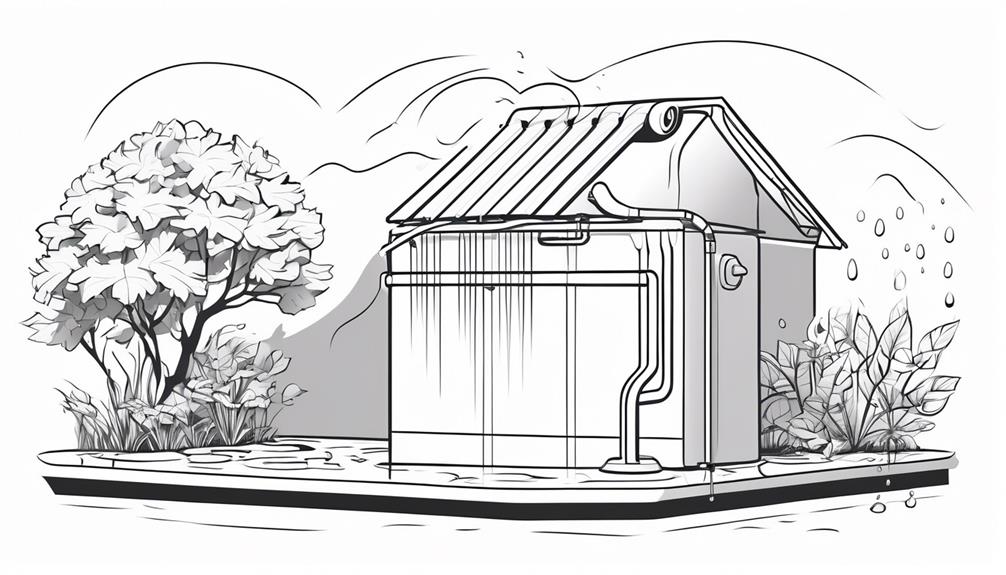Imagine rainwater as nature's gift, a precious resource waiting to be harnessed for a greater good.
Have you ever considered the impact of capturing this abundant yet often overlooked source of water? Rainwater harvesting holds a key to unlocking sustainable water conservation practices that can make a significant difference in our environment and communities.
But how exactly does this process work, and what role does it play in the broader context of water conservation?
Let's explore the world of rainwater harvesting and its implications together.
Key Takeaways
- Rainwater harvesting contributes to sustainable water supply and management
- Adoption of rainwater harvesting supports effective water preservation and conservation efforts
- Rainwater harvesting empowers individuals to take control over their water usage
- Regulatory support, education programs, research funding, and a supportive environment are crucial factors in promoting rainwater harvesting for water conservation
Benefits of Rainwater Harvesting
By harnessing rainwater, you unlock a wealth of benefits that can positively impact both your wallet and the environment. Imagine the satisfaction of seeing your water bill decrease as you use rainwater for tasks like watering your garden or flushing toilets. Not only will you save money, but you'll also reduce the demand on local water sources, contributing to water conservation efforts.
Picture lush plants thriving from the pure, untreated rainwater they receive, free from the chemicals found in tap water. Additionally, by collecting rainwater, you can decrease the risk of flooding in your area as less water runs off into storm drains.
The simplicity of installing a rainwater harvesting system can bring a sense of accomplishment and empowerment as you take control of your water usage. Embrace the beauty of sustainability by utilizing this natural resource to its fullest potential, benefiting both yourself and the world around you.
Methods for Rainwater Collection
Unlock the potential of rainwater by exploring practical methods for collecting this valuable resource efficiently and effectively.
Start with a simple yet effective method – rain barrels. These large containers positioned under downspouts collect rainwater for later use in gardening or washing your car.
Another method is installing a rain chain, which guides rainwater from your roof into a storage container or a rain garden.
Consider a more advanced approach by setting up a rainwater harvesting system connected to your home's plumbing. This system can collect and filter rainwater for everyday use, reducing your reliance on the municipal water supply.
Additionally, green roofs, covered in vegetation, absorb rainwater and reduce runoff.
For larger-scale collection, think about constructing a rainwater harvesting pond to store significant amounts of rainwater for irrigation or wildlife habitat.
Potential Impact on Water Resources
Let's explore how rainwater harvesting can make a significant impact on water resources.
By preserving water resources, rainwater collection helps in ensuring a sustainable water supply for future generations.
The benefits of rainwater harvesting contribute to effective and eco-friendly water management practices.
Water Resource Preservation
To preserve water resources effectively, consider implementing rainwater harvesting techniques to reduce dependency on traditional water sources. By collecting rainwater from rooftops and storing it for later use, you can decrease the strain on local water supplies. This method not only helps in water conservation but also aids in maintaining a sustainable water cycle.
Imagine the impact of capturing rainwater to water your garden, wash your car, or even flush toilets. Every drop saved through rainwater harvesting contributes to the preservation of our precious water resources. With simple installations like rain barrels or more complex systems, you can actively participate in safeguarding water for future generations.
Start your journey towards water resource preservation today with rainwater harvesting!
Rainwater Collection Benefits
Harnessing rainwater offers numerous benefits, positively impacting water resources through sustainable conservation practices. By collecting rainwater, you can reduce your reliance on municipal water sources, easing the burden on freshwater reserves. This practice not only helps in times of drought but also lessens the strain on existing water infrastructure.
Rainwater harvesting also aids in preventing erosion and flooding by capturing water that would otherwise run off into storm drains. Additionally, using collected rainwater for irrigation can lead to healthier gardens and landscapes, saving potable water for essential needs.
Sustainable Water Management
With the benefits of rainwater collection in mind, managing water sustainably can have a significant impact on water resources, ensuring long-term conservation and availability.
Implementing sustainable water management practices such as rainwater harvesting helps reduce the strain on traditional water sources like rivers and groundwater. By capturing rainwater for various uses like irrigation, washing, and flushing, you can decrease reliance on finite water supplies.
This conservation method also aids in preventing water runoff, which can carry pollutants into water bodies, further safeguarding water quality.
Sustainable water management not only conserves water but also promotes efficient usage, contributing to the overall health and resilience of water resources for future generations.
Rainwater Harvesting Systems and Components

Using a network of gutters, downspouts, and storage tanks, rainwater harvesting systems collect and store rainwater for various uses. Gutters are installed along the roofline to catch rainwater and direct it towards downspouts. Downspouts then channel the water into storage tanks for future use. These tanks can vary in size and material, such as plastic or concrete, and are equipped with filters to remove debris and prevent contamination.
Components like first flush diverters help in discarding the initial runoff that may contain pollutants. In addition, screens prevent leaves and larger particles from entering the system. Many systems also include pumps to distribute collected rainwater for irrigation, household chores, and even drinking with proper filtration.
Having a well-designed rainwater harvesting system can significantly reduce reliance on mains water supply, especially during dry seasons. It not only conserves water but also helps in managing stormwater runoff, reducing erosion, and replenishing groundwater. By incorporating these components, rainwater harvesting becomes an efficient and sustainable water conservation practice.
Importance of Rainwater Harvesting in Drought-Prone Areas
In drought-prone areas, the ability to capture and store rainwater holds immense significance for ensuring water availability during dry spells. Rainwater harvesting becomes a lifeline in these regions, where water scarcity is a constant threat. Picture this: as rain falls, it collects on rooftops, flows through gutters, and is channeled into storage tanks. Instead of this precious resource going to waste, it's harnessed for later use.
When drought strikes and traditional water sources run dry, these stored reserves become invaluable. With rainwater harvesting systems in place, communities can rely on this reserve to meet their water needs for drinking, agriculture, and sanitation. It's like having a savings account for water – you build it up during the rainy season to tide you over in the dry season.
The practice not only helps mitigate the impact of droughts but also promotes self-sufficiency and resilience in the face of unpredictable weather patterns.
Government Regulations and Incentives

How do government regulations and incentives drive the adoption of rainwater harvesting practices in communities?
Governmental involvement is crucial in promoting sustainable water practices like rainwater harvesting. Here's how it plays out:
- Financial Incentives: Many governments offer rebates or financial assistance to individuals or communities that implement rainwater harvesting systems, making it a more financially attractive option.
- Regulatory Support: Some regions have made rainwater harvesting mandatory for new constructions or provide incentives like tax breaks for those who install rainwater harvesting systems.
- Education and Outreach Programs: Governments often run campaigns to educate the public about the benefits of rainwater harvesting and provide resources on how to get started.
- Research and Development Funding: Governments may allocate funds for research into improving rainwater harvesting technology, making systems more efficient and cost-effective.
These factors combined create a supportive environment that encourages more widespread adoption of rainwater harvesting, ultimately contributing to water conservation efforts.
Frequently Asked Questions
What Are the Maintenance Requirements for a Rainwater Harvesting System?
To keep your rainwater harvesting system running smoothly, regular maintenance is key. Clear debris from gutters, inspect for leaks, and ensure the storage tank is clean. By staying on top of these tasks, you'll maximize efficiency.
How Does Rainwater Harvesting Impact Water Quality Compared to Traditional Water Sources?
When it comes to water quality, rainwater harvesting offers a natural purification process as it bypasses the pollution risks associated with traditional water sources. Enjoy cleaner water for various uses with this eco-friendly solution.
Can Rainwater Harvesting Be Integrated Into Existing Buildings and Infrastructure?
Yes, rainwater harvesting can easily integrate into existing buildings and infrastructure. Gutters and downspouts collect rainwater, which is then stored in tanks or cisterns. This stored water can be used for various purposes like irrigation and flushing toilets.
What Are the Limitations of Rainwater Harvesting in Urban Areas With Limited Space?
In urban areas with limited space, rainwater harvesting faces challenges like finding suitable storage locations and dealing with restricted surface areas for collection. These limitations can impact the efficiency of your water conservation efforts.
How Does Rainwater Harvesting Contribute to Overall Water Sustainability and Resilience in Communities?
You know, rainwater harvesting acts like a superhero for communities, boosting water sustainability. It collects precious raindrops, lessening demand on traditional sources. It's like a secret weapon making neighborhoods more resilient and self-sufficient.
Conclusion
You've learned about the vital role rainwater harvesting plays in water conservation.
Imagine a vibrant garden, nourished by rainwater collected from your rooftop.
Picture a world where every drop of rain is captured, helping to sustain our precious water resources.
By implementing rainwater harvesting systems, you can contribute to a greener future and a more sustainable environment.
So start collecting rainwater today and watch your surroundings flourish with life.
